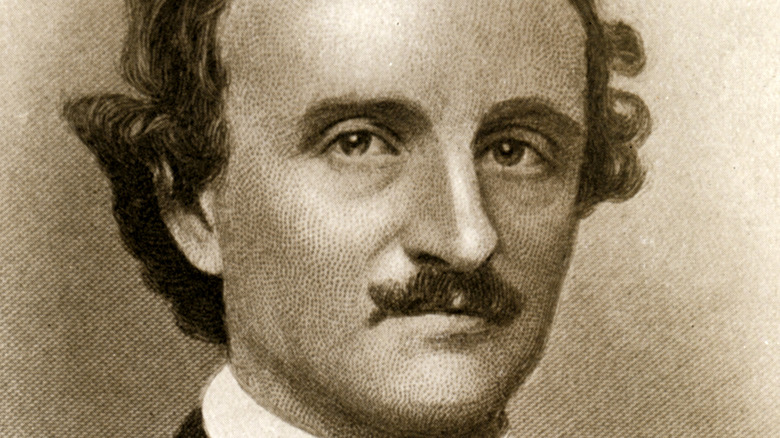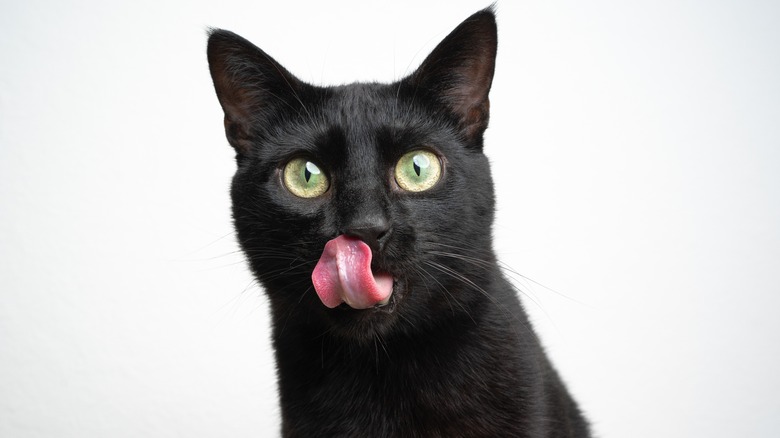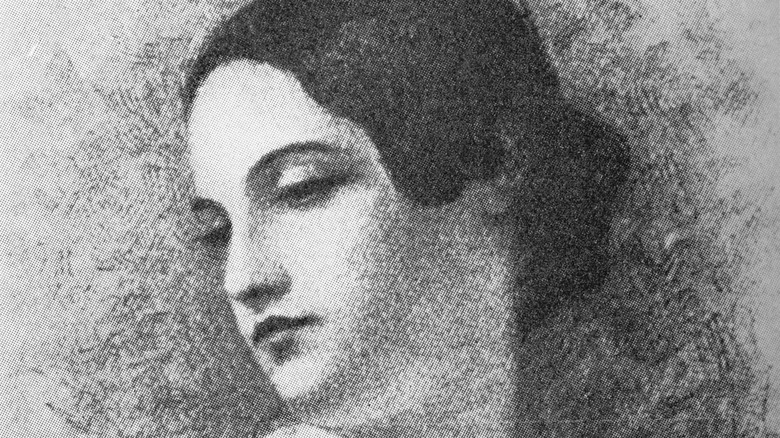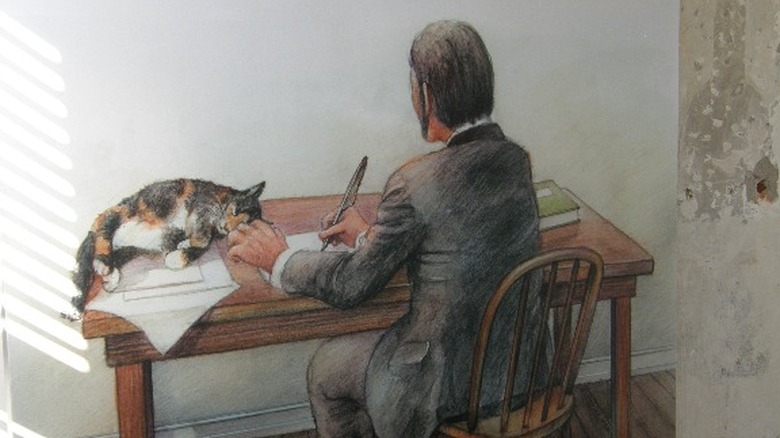Edgar Allan Poe Took Writing Inspiration From An Unexpected Source
When it comes to animal muses, pioneering U.S. horror writer Edgar Allan Poe is most famous for his association with corvids. His poem "The Raven," from its opening line of "Once upon a midnight dreary" to the titular bird's constant refrain of "Nevermore" (via Poetry Foundation), is a spooky-season classic that has been spoofed by everything from "The Simpsons" (on YouTube) to (also on YouTube) "Saturday Night Live." But Poe also took inspiration from another animal often associated with Halloween: the cat.
Poe in fact had a beloved pet cat named, appropriately, Catterina, according to the National Park Service. Catterina liked to sit at Poe's desk while he wrote, and there is now a drawing of the two of them, hanging in one of his Philadelphia homes that has been preserved as a National Historic Site. One English woman who visited Poe and his family when they lived in Fordham, in what is now the Bronx, also described Poe and his cat's mutual affection. "A favourite cat, too, enjoyed his friendly patronage, and often when he was engaged in composition it seated itself on his shoulder, purring as if in complacent approval of the work proceeding under its supervision," the woman told her friend (via The Edgar Allan Poe Society of Baltimore). Catterina may have been the inspiration behind two Poe pieces featuring felines: the short story "The Black Cat" and the essay "Instinct vs. Reason — A Black Cat."
The Black Cat
His short story "The Black Cat" (via American Studies at the University of Virginia) does not at first seem to be a very cat-friendly tale. It tells the chilling tale of a once kind man who becomes angry and unpredictable when he develops an addiction to alcohol. One sign of the narrator's change is his attitude toward animals in general and his favorite cat in particular. Pluto is a black cat that is described as "a remarkably large and beautiful animal, entirely black, and sagacious to an astonishing degree." However, the narrator turns on Pluto as part of his moral deterioration, at first gouging out one of his eyes with a penknife and later hanging him from a tree.
Later, he encounters another black cat while out drinking. At first, he is enamored of this new companion, who approaches him affectionately and follows him home. Eventually, though, guilt sours his attitude towards the second pet, who is exactly like Pluto, down to the missing eye, except for a white spot at his neck that comes to resemble a noose. The disturbed narrator tries to kill this living ghost with an ax, but his wife intervenes and he kills her instead, burying her body in the cellar walls. What he doesn't notice is that he walled the cat up with her. This is discovered when the police come to investigate and hear an inhuman cry coming from behind the plaster, leading them to uncover the corpse. The cat that the narrator tried to kill has therefore doomed him.
If you or anyone you know needs help with addiction issues, help is available. Visit the Substance Abuse and Mental Health Services Administration website or contact SAMHSA's National Helpline at 1-800-662-HELP (4357).
Art and life
"The Black Cat" at first read places the titular cat in a negative light. When the narrator's wife's body is uncovered, he describes the scene like this: "Upon its head, with red extended mouth and solitary eye of fire, sat the hideous beast whose craft had seduced me into murder, and whose informing voice had consigned me to the hangman." However, it's fairly clear that the protagonist of "The Black Cat" is an unreliable narrator. Seen from outside his self-justifying insanity, the cat is an intelligent but innocent animal that ultimately secures justice for its murdered mistress.
How likely is it that the story's two black cats were inspired by Catterina? Catterina was a female tortoiseshell cat, not a black male, according to The Guardian. But historical accounts confirm that she acted with perceived intelligence. For example, when Poe's wife Virginia Clemm (above) was dying of tuberculosis in Fordham in the winter of 1846 to 1847, a visiting woman described Catterina as curling up on the invalid's chest to keep her warm (via "Travels in Philadelphia" by Christopher Morley, posted at Internet Archive). "The wonderful cat seemed conscious of her great usefulness," the woman wrote.
"The Black Cat" was written in 1843, so the titular feline's role as the doomed wife's avenger could not have been inspired by Catterina's deathbed faithfulness. However, her overall ingenious and affectionate nature might have inspired the fictional cats.
Remarkable muse
The connection between Catterina and "The Black Cat" is bolstered by an essay Poe published in 1840 titled "Instinct vs. Reason — A Black Cat" (also posted at The Edgar Allan Poe Society of Baltimore). In this essay, Poe describes a female black cat that he knows personally in similar terms to how Pluto is described in the story. "The writer of this article is the owner of one of the most remarkable black cats in the world — and this saying much; for it will be remembered that black cats are all of them witches," Poe writes in the essay. In "The Black Cat," Pluto is described as "remarkably large and beautiful." In addition, the narrator's wife makes a similar comment about black cats and witches.
In the essay, Poe describes how his cat has figured out how to get to her favorite part of the kitchen, even though it's blocked by a door that uses a "thumb-latch." Despite not having opposable thumbs, the cat still manages to open the door by jumping up, pressing down on the latch, and using her body weight to force the door open. The entire point of the piece is that the cat's smarts puts the value of human intelligence in question. "The black cat, in doing what she did, must have made use of all the perceptive and reflective faculties which we are in the habit of supposing the prescriptive qualities of reason alone," Poe concludes. In both pieces, the feline protagonists outsmart the human narrators.



